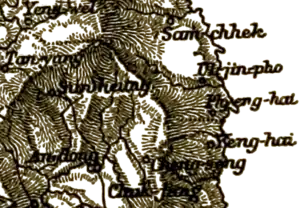| Sunheung Township | |||||||
|---|---|---|---|---|---|---|---|
 A detail from a 1904 map of Korea, showing "Sun-heung" as the largest town northwest of the provincial capital Andong | |||||||
| Korean name | |||||||
| Hangul | 순흥면 | ||||||
| Hanja | 順興面 | ||||||
| Literal meaning | The Township of Following Prosperity | ||||||
| |||||||
Sunheung is a township administered as part of the municipality of Yeongju in North Gyeongsang, South Korea. The present local government administers an area of 54.35 square kilometers (20.98 sq mi).
Located in Sunheung is Sosu Seowon, a Neo-Confucian Academy built in the 16th century and today a UNESCO World Heritage Site.
Name
Sunheung is an anglicization of the McCune–Reischauer romanization Sunhŭng. Its official romanization in South Korea is Sunheung. In 19th century sources, Sunheung appears as Sioun-heng-fu,[1] from a French transcription of the Korean placename and the Chinese pronunciation of its status as the seat of a district or commandery. Although the name literally means "Adhering to", "Obeying", or "Following Prosperity" or "Success", Sunheung is also Bon-gwan of a Korean clan in the area which included the influential Korean Confucianist An Hyang.
History
Under the late Joseon dynasty, Sunheung was a district capital overseeing the plains and hinterland around Mount Taebaek. Its mountains were the site of Korea's first foreign mining concern, a silver mine whose permit was revoked by the royal court in Seoul after a few months of operation in the early 1850s.[1][2]
See also
References
Citations
Bibliography
- , Encyclopædia Britannica, 9th ed., Vol. VI, New York: Charles Scribner's Sons, 1878, pp. 390–394.
- Dallet, Charles (1874), "Introduction", Histoire de l'Église de Corée, Paris: Victor Palmé. (in French)
External links
- "Old Korea, Pt. I", a partial English translation of Dallet's History of the Korean Church at Lotus & Persimmon